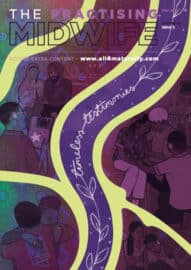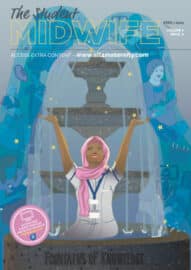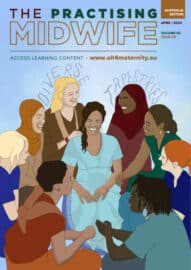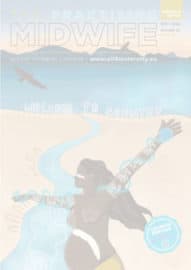I Guideline Commentary: NICE Guideline: Intrapartum care for women with existing medical conditions or obstetric complications and their babies 2019
Lucy Evans Midwifery Lecturer, Swansea University
Introduction
 In the UK the national institute for health and care excellence (NICE) is a non-departmental public body that strives for excellence in clinical health and social care. The purpose of the board creating guidelines is primarily to strive for excellence and reduce variation in care. New guidance has been published by NICE on intrapartum care for women with existing medical conditions or obstetric complications and their babies. With increasing numbers of more complex births in the UK this guideline is aimed at supporting practitioners in developing appropriate plans of care in partnership with women. Part of the work conducted by MBBRACE includes researching confidential enquires into maternal deaths within the UK, ensuring findings are visible to the public and practitioners. Findings highlight that improvements in care can reduce the risk of maternal mortality and morbidity and so clear guidance for complex needs is welcomed. This review will summarise some of the contents of the guidance, critically consider the messages it contains, and look at the implications for women and for midwives.
In the UK the national institute for health and care excellence (NICE) is a non-departmental public body that strives for excellence in clinical health and social care. The purpose of the board creating guidelines is primarily to strive for excellence and reduce variation in care. New guidance has been published by NICE on intrapartum care for women with existing medical conditions or obstetric complications and their babies. With increasing numbers of more complex births in the UK this guideline is aimed at supporting practitioners in developing appropriate plans of care in partnership with women. Part of the work conducted by MBBRACE includes researching confidential enquires into maternal deaths within the UK, ensuring findings are visible to the public and practitioners. Findings highlight that improvements in care can reduce the risk of maternal mortality and morbidity and so clear guidance for complex needs is welcomed. This review will summarise some of the contents of the guidance, critically consider the messages it contains, and look at the implications for women and for midwives.
Summary of the Guidance
The guideline addresses many health complications that have the potential to affect birth choices. The guideline does not cover all medical conditions but offers suggestions for a selection with recommendations for further research.
The first part of the guideline recommends providing women with existing medical complications information on their care and their clarifying their preferences. This may seem an obvious part of maternity care, however these women will require input from the multidisciplinary team and so clear guidance on these important conversations might be useful.
In section 1.2.1 the sharing of care plans is recommended; however, it is disappointing that the community midwife is not listed in the professionals that need to be informed of those plans. This seems like an oversight given the pivotal role of the community midwife as the coordinator of care for women with complex needs.
The subsequent sections of the guideline provide clear recommendations for specific conditions including; heart disease; asthma; long-term systemic steroids; bleeding disorders; subarachnoid haemorrhage or arteriovenous malformation of the brain; acute kidney injury or chronic kidney disease; obesity; information for women with obstetric complications or no antenatal care; pyrexia; sepsis; intrapartum haemorrhage; breech presenting in labour; small for gestational age baby; large for gestational age baby; no antenatal care; previous caesarean section; and labour after 42 weeks of pregnancy. This quite comprehensive list is a useful resource for midwives and other health professionals.
However, there are some issues that arise from review of the guideline:
- In the section on obesity recommendations are made for birth positions, fetal monitoring, assessing fetal position and potential equipment required. Although the guideline stipulates that obesity in isolation will not necessary require all of these interventions, it is interesting to consider why the committee have set the BMI threshold as over 30. Often women with a BMI under 35 receive midwifery led-care and birth outside of an obstetric unit, have low intervention, and often experience mobile births. This threshold from NICE may lead to increased intervention for women with a BMI of 30-35.
- Section 1.13 offers guidance for the management of sepsis. The guidance in this section details the professionals required and makes recommendations around analgesia. However, it is disappointing not to see reference to national policy and proformas such as ‘sepsis six’ which would offer a more joined-up approach to care. As sepsis remains one of the leading causes of maternal death in the UK this reference would further support effective care. Additionally, there is no mention of the importance of IV antibiotics within the first hour of suspecting sepsis to improve outcomes.
- The section on large for gestational age baby 1.17 mentions the higher chance of shoulder dystocia and brachial plexus injury with vaginal birth, however there is no reference to the increased risk being greatly associated with diabetes and the weight distribution of these macrocosmic babies which is different for large for gestational age babies. Currently the evidence supports offering induction for EFW above the 90th percentile to reduce the risk of shoulder dystocia and brachial plexus injury despite the associated increasing risk of perineal trauma.
From a positive perspective, Section 1.19 outlines recommendations for caring for women with a previous caesarean section. It is refreshing to see that recommendations surrounding analgesia include supporting women who choose to labour and birth in water. In addition to this, the guidance supports the practice of not routinely sighting an IV cannula if previous caesarean is the only risk factor; further supporting women to labour and birth in water which will increase the likelihood of a normal birth.
Implications for midwives
The overall theme running throughout this guideline is referral to the multidisciplinary team which is not a new phenomenon for midwives, but which can remind us that we are not required to possess expert knowledge in all aspects of complex cases.
This guideline is useful for midwives; as experts in normal labour care it can be challenging for midwives to feel confident in caring for women with additional  medical needs. The overall theme running throughout this guideline is referral to the multidisciplinary team which is not a new phenomenon for midwives, but which can remind us that we are not required to possess expert knowledge in all aspects of complex cases. It underlines the importance of ensuring these women have coordinated and appropriate care as an essential of effective midwifery practice.
medical needs. The overall theme running throughout this guideline is referral to the multidisciplinary team which is not a new phenomenon for midwives, but which can remind us that we are not required to possess expert knowledge in all aspects of complex cases. It underlines the importance of ensuring these women have coordinated and appropriate care as an essential of effective midwifery practice.
Midwives utilising this guideline should do so with caution remembering that guidelines are GUIDElines and should always be used on an individual basis. Many women with complex medical conditions may present with more than one risk factor. Women’s own needs and preferences should be accounted for and women should be supported in collaborative decision making, following effective information sharing. The woman’s decision is the one that determines care.
Conclusion
There is increasing emphasis on the need for midwives to support women with more complex factors affecting pregnancy and birth. This guidance focuses largely on specific, practical advice on how to care for women with particular complex needs. However, limitations, as discussed, apply. It is also important to consider that some of the advice could be questioned in light of other evidence and guidance, particularly regarding obesity and could affect the government recommendations for birthing outside an obstetric unit. As a resource, it has some value for women, but should be used, as all guidelines are, as one of many sources of information to guide collaborative, woman-centred care and woman-led decision making. TPM
Acknowledgements
The author would like to thank Dr Alys Einion-Waller for her assistance in preparing this commentary.







